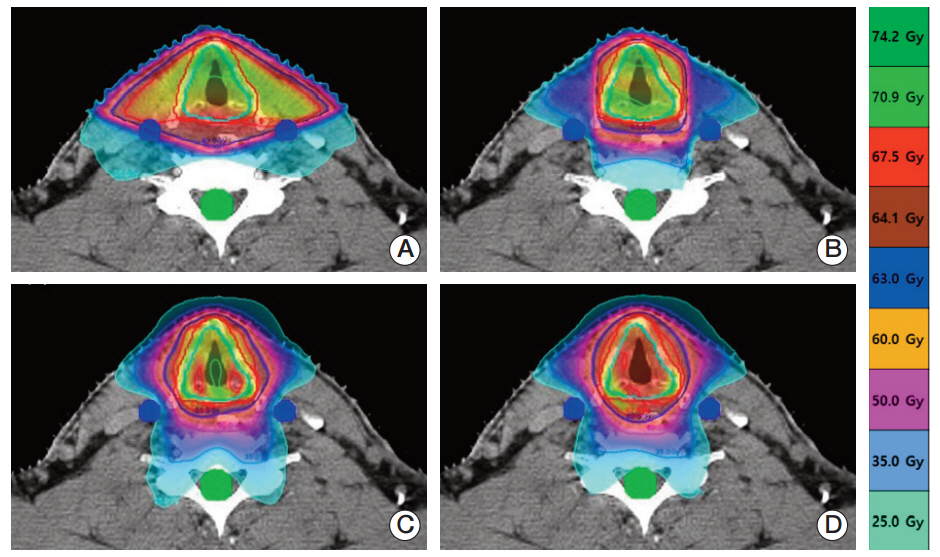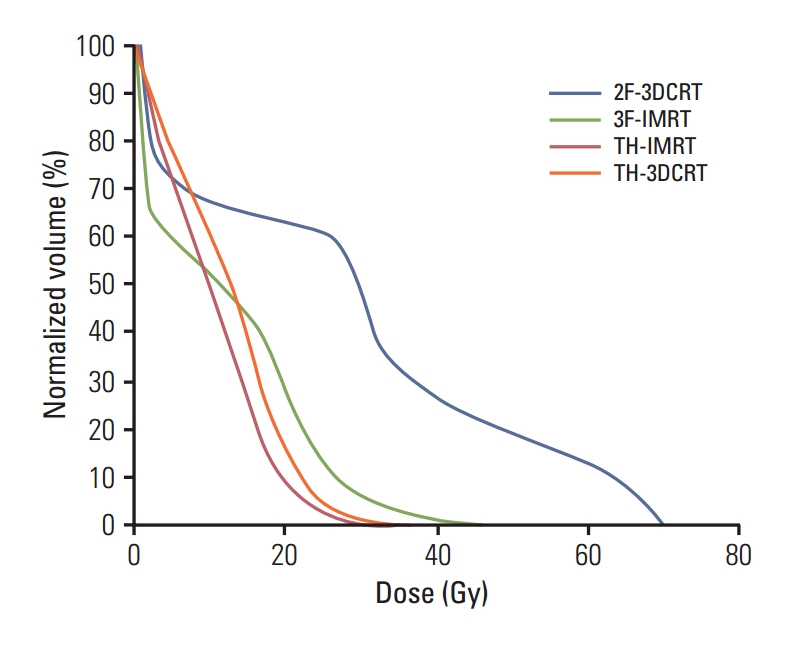Cancer Res Treat.
2016 Jan;48(1):63-70. 10.4143/crt.2014.265.
Carotid-Sparing TomoHelical 3-Dimensional Conformal Radiotherapy for Early Glottic Cancer
- Affiliations
-
- 1Department of Radiation Oncology, Samsung Medical Centre, Sungkyunkwan University School of Medicine, Seoul, Korea. sg.ju@samsung.com, ahnyc@skku.edu
- 2Department of Biomedical Engineering and Research Institute of Biomedical Engineering, The Catholic University of Korea, Seoul, Korea.
- KMID: 2152261
- DOI: http://doi.org/10.4143/crt.2014.265
Abstract
- PURPOSE
The purpose of this study was to investigate the dosimetric benefits and treatment efficiency of carotid-sparing TomoHelical 3-dimensional conformal radiotherapy (TH-3DCRT) for early glottic cancer.
MATERIALS AND METHODS
Ten early-stage (T1N0M0) glottic squamous cell carcinoma patients were simulated, based on computed tomography scans. Two-field 3DCRT (2F-3DCRT), 3-field intensity-modulated radiation therapy (3F-IMRT), TomoHelical-IMRT (TH-IMRT), and TH-3DCRT plans were generated with a 67.5-Gy total prescription dose to the planning target volume (PTV) for each patient. In order to evaluate the plan quality, dosimetric characteristics were compared in terms of conformity index (CI) and homogeneity index (HI) for PTV, dose to the carotid arteries, and maximum dose to the spinal cord. Treatment planning and delivery times were compared to evaluate treatment efficiency.
RESULTS
The median CI was substantially better for the 3F-IMRT (0.65), TH-IMRT (0.64), and TH-3DCRT (0.63) plans, compared to the 2F-3DCRT plan (0.32). PTV HI was slightly better for TH-3DCRT and TH-IMRT (1.05) compared to 2F-3DCRT (1.06) and 3F-IMRT (1.09). TH-3DCRT, 3F-IMRT, and TH-IMRT showed an excellent carotid sparing capability compared to 2F-3DCRT (p < 0.05). For all plans, the maximum dose to the spinal cord was < 45 Gy. The median treatment planning times for 2F-3DCRT (5.85 minutes) and TH-3DCRT (7.10 minutes) were much lower than those for 3F-IMRT (45.48 minutes) and TH-IMRT (35.30 minutes). The delivery times for 2F-3DCRT (2.06 minutes) and 3F-IMRT (2.48 minutes) were slightly lower than those for TH-IMRT (2.90 minutes) and TH-3DCRT (2.86 minutes).
CONCLUSION
TH-3DCRT showed excellent carotid-sparing capability, while offering high efficiency and maintaining good PTV coverage.
Keyword
MeSH Terms
Figure
Reference
-
References
1. Teshima T, Chatani M, Inoue T. Radiation therapy for early glottic cancer (T1N0M0): II. prospective randomized study concerning radiation field. Int J Radiat Oncol Biol Phys. 1990; 18:119–23.2. Chatani M, Matayoski Y, Masaki N, Teshima T, Inoue T. Radiation therapy for early glottic carcinoma (T1N0M0): the final results of prospective randomized study concerning radiation field. Strahlenther Onkol. 1996; 172:169–72.
Article3. Brown PD, Foote RL, McLaughlin MP, Halyard MY, Ballman KV, Collie AC, et al. A historical prospective cohort study of carotid artery stenosis after radiotherapy for head and neck malignancies. Int J Radiat Oncol Biol Phys. 2005; 63:1361–7.
Article4. Smith GL, Smith BD, Buchholz TA, Giordano SH, Garden AS, Woodward WA, et al. Cerebrovascular disease risk in older head and neck cancer patients after radiotherapy. J Clin Oncol. 2008; 26:5119–25.
Article5. Dorresteijn LD, Kappelle AC, Boogerd W, Klokman WJ, Balm AJ, Keus RB, et al. Increased risk of ischemic stroke after radiotherapy on the neck in patients younger than 60 years. J Clin Oncol. 2002; 20:282–8.
Article6. Chera BS, Amdur RJ, Morris CG, Mendenhall WM. Carotidsparing intensity-modulated radiotherapy for early-stage squamous cell carcinoma of the true vocal cord. Int J Radiat Oncol Biol Phys. 2010; 77:1380–5.
Article7. Rosenthal DI, Fuller CD, Barker JL Jr, Mason B, Garcia JA, Lewin JS, et al. Simple carotid-sparing intensity-modulated radiotherapy technique and preliminary experience for T1-2 glottic cancer. Int J Radiat Oncol Biol Phys. 2010; 77:455–61.
Article8. Gomez D, Cahlon O, Mechalakos J, Lee N. An investigation of intensity-modulated radiation therapy versus conventional two-dimensional and 3D-conformal radiation therapy for early stage larynx cancer. Radiat Oncol. 2010; 5:74.
Article9. Chatterjee S, Guha S, Prasath S, Mallick I, Achari R. Carotid sparing hypofractionated tomotherapy in early glottic cancers: refining image guided IMRT to improve morbidity. J Cancer Res Ther. 2013; 9:452–5.10. Cheung K. Intensity modulated radiotherapy: advantages, limitations and future developments. Biomed Imaging Interv J. 2006; 2:e19.
Article11. Court LE, Seco J, Lu XQ, Ebe K, Mayo C, Ionascu D, et al. Use of a realistic breathing lung phantom to evaluate dose delivery errors. Med Phys. 2010; 37:5850–7.12. Osman SO, de Boer HC, Astreinidou E, Gangsaas A, Heijmen BJ, Levendag PC. On-line cone beam CT image guidance for vocal cord tumor targeting. Radiother Oncol. 2009; 93:8–13.
Article13. van Asselen B, Raaijmakers CP, Lagendijk JJ, Terhaard CH. Intrafraction motions of the larynx during radiotherapy. Int J Radiat Oncol Biol Phys. 2003; 56:384–90.
Article14. Paddick I. A simple scoring ratio to index the conformity of radiosurgical treatment plans. Technical note. J Neurosurg. 2000; 93 Suppl 3:219–22.15. Prasana Sarathy N. Evaluation of three dimensional conformal versus field in field forward IMRT planning for intact breast irradiation. Mumbai: Association of Medical Physicists of India;2008. p. 32–3.16. Martin JD, Buckley AR, Graeb D, Walman B, Salvian A, Hay JH. Carotid artery stenosis in asymptomatic patients who have received unilateral head-and-neck irradiation. Int J Radiat Oncol Biol Phys. 2005; 63:1197–205.
Article17. Ki YK, Kim WT, Nam JH, Kim DH, Lee JH, Park D, et al. Treatment planning for minimizing carotid artery dose in the radiotherapy of early glottic cancer. J Korean Soc Ther Radiol Oncol. 2011; 29:115–20.
Article18. Riegel AC, Antone J, Schwartz DL. Comparative dosimetry of volumetric modulated arc therapy and limited-angle static intensity-modulated radiation therapy for early-stage larynx cancer. Med Dosim. 2013; 38:66–9.
Article19. Moran JM, Dempsey M, Eisbruch A, Fraass BA, Galvin JM, Ibbott GS, et al. Safety considerations for IMRT: executive summary. Pract Radiat Oncol. 2011; 1:190–5.
Article20. Fraass BA, Marks LB, Pawlicki T; ASTRO Multidisciplinary Quality Assurance Subcommittee. Commentary: safety considerations in contemporary radiation oncology: introduction to a series of ASTRO safety white papers. Pract Radiat Oncol. 2011; 1:188–9.
Article21. Bertelsen A, Hansen CR, Johansen J, Brink C. Single arc volumetric modulated arc therapy of head and neck cancer. Radiother Oncol. 2010; 95:142–8.
Article22. Dantas RO, Kern MK, Massey BT, Dodds WJ, Kahrilas PJ, Brasseur JG, et al. Effect of swallowed bolus variables on oral and pharyngeal phases of swallowing. Am J Physiol. 1990; 258(5 Pt 1):G675–81.
Article23. Leonard RJ, Kendall KA, McKenzie S, Goncalves MI, Walker A. Structural displacements in normal swallowing: a videofluoroscopic study. Dysphagia. 2000; 15:146–52.
Article24. Osman SO, Astreinidou E, Levendag PC, Heijmen BJ. Impact of geometric variations on delivered dose in highly focused single vocal cord IMRT. Acta Oncol. 2014; 53:278–85.
Article25. Levendag PC, Teguh DN, Keskin-Cambay F, Al-Mamgani A, van Rooij P, Astreinidou E, et al. Single vocal cord irradiation: a competitive treatment strategy in early glottic cancer. Radiother Oncol. 2011; 101:415–9.
Article
- Full Text Links
- Actions
-
Cited
- CITED
-
- Close
- Share
- Similar articles
-
- Volumetric modulated arc therapy for carotid sparing in the management of early glottic cancer
- Carotid sparing intensity modulated radiotherapy on early glottic cancer: preliminary study
- Treatment Planning for Minimizing Carotid Artery Dose in the Radiotherapy of Early Glottic Cancer
- Hypofractionated radiotherapy for early glottic cancer: a retrospective interim analysis of a single institution
- Radiotherapy of Early Stage Glottic Cancer



